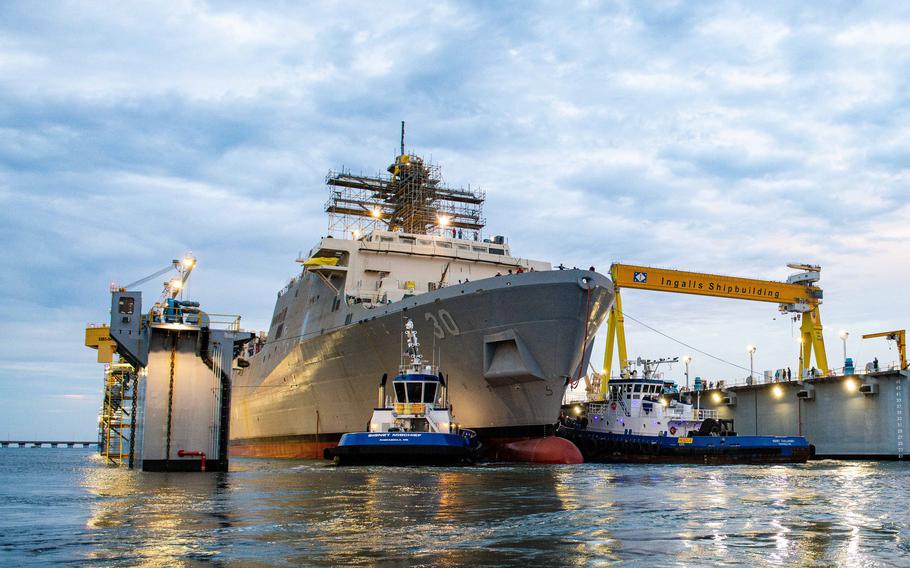
Harrisburg LPD-30, a Flight II San Antonio-class amphibious transport dock ship, was launched by Huntington Ingalls Shipbuilding in Pascagoula, Miss., Oct. 5, 2024. (Huntington Ingalls Shipbuilding)
Shipbuilder Huntington Ingalls recently launched the first Flight II San Antonio-class amphibious warship, the Virginia-based firm said in a Tuesday news release.
The ship, a landing transport dock designated Harrisburg LPD-30, was moved from the yard to the company’s floating dry dock at its Pascagoula, Miss., shipyard using a specialized railway system.
The move marked “one of the first major milestones in the ship’s journey towards operational readiness,” the news release states.
“We view this launch as a significant step toward fielding capability to our U.S. Navy and Marine Corps partners, and a reminder of the importance of supporting national security,” Kari Wilkinson, president of Ingalls Shipbuilding, said in the news release.
Transport dock ships are designed to carry a landing force for expeditionary warfare missions. They carry Marines, supplies and landing craft and possess landing pads for helicopters or Osprey tiltrotor aircraft.
The shipyard has a second Flight II under construction, LPD-31, designated Pittsburgh, with LPD-32, Philadelphia, still in the planning stage.
The Navy’s amphibious ship force is made up entirely of large amphibious ships, according to a Sept. 25 report by the Congressional Research Service.
The force consists of “big-deck” amphibious assault ships designated LHA or LHD that look like medium-sized aircraft carriers and the somewhat smaller ships designated LPD or LSD, sometimes referred to as “small-deck” ships, the report states.
The fiscal year 2023 National Defense Authorization Act required the Navy fleet to include no fewer than 31 operational amphibious ships, of which at least 10 must be big-deck amphibs.
The Navy amphib fleet includes 13 Flight I landing platform docks.
The Flight II LPDs are somewhat cheaper to procure than the previous Flight I versions, but it comes with a tradeoff, the CRS report states.
The Flight II versions are “in some ways less capable — a reflection of how the Flight II design was developed to meet Navy and Marine Corps operational requirements while staying within a unit procurement cost target that had been established for the program,” the report states.
The Navy’s current force-level goal calls for procuring 13 Flight II amphibs at an estimated cost of $2 billion each, the CRS report states.
The Navy expects delivery of the Harrisburg in the fiscal year beginning Oct. 1, 2025, according to a June report by the Government Accountability Office.